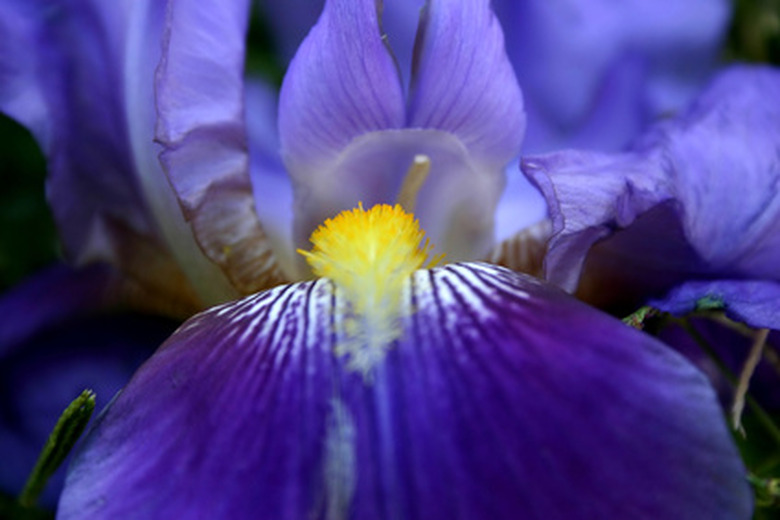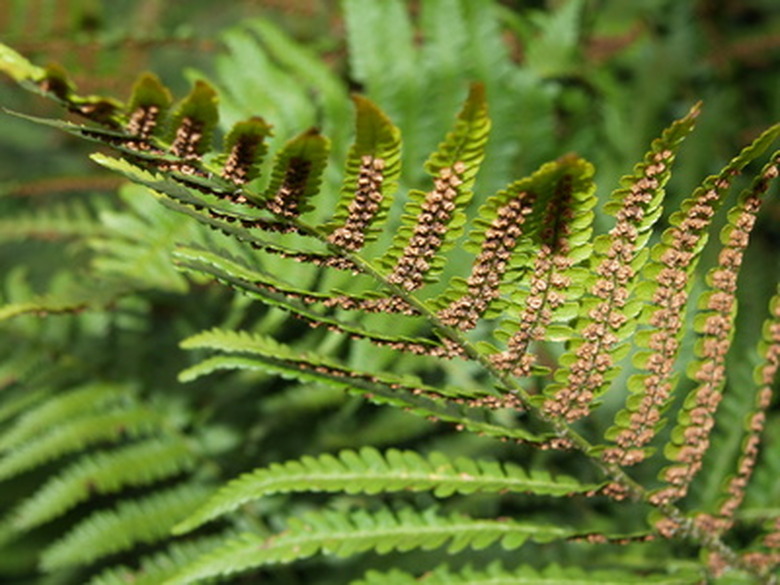What Is The Difference Between A Spore & A Pollen Grain?
Do ferns have pollen? The answer is no, because ferns are spore-bearing plants. While seed-bearing plants like corn make pollen, spores are reproductive structures of seedless vascular plants like ferns. There are several differences between spores and pollen grains. One of the most important differences is the fact that spores are unicellular and pollen grains are multicellular.
What's a Spore?
What's a Spore?
To define "spore," it's essential to understand how spore-bearing plants reproduce. Ferns, horsetails and club mosses are some of the types of seedless vascular plants that make spores. The term "vascular plants" refers to the fact that these plants have xylem and phloem, vascular tissues that move water and nutrients around the plant structure. Mosses, liverworts and hornworts are examples of plants that do not have vascular tissues.
Seedless vascular plants like ferns that produce spores require water for their life cycle, unlike vascular plants that make pollen and seeds. Spores are unicellular, meaning that they consist of a single cell. Because they are only made of one cell, they are haploid, referring to the fact that they only have one set of chromosomes.
Spores are the reproductive structures produced by the mature sporophyte of seedless vascular plants. After spores germinate, they grow into gametophytes, which are haploid. The gametophytes of seedless plants are usually small, but they are the generation of the plants that develop antheridia and archegonia, the sexual structures of the plant. Once fertilization occurs in an archegonium of a gametophyte, the diploid zygote becomes a sporophyte, and the life cycle of a spore-bearing plant begins again.
Pollen Grain Definition
Pollen Grain Definition
A pollen grain is a multicellular reproductive structure of a seed plant. Unlike spores, pollen grains are diploid, which means that they contain two sets of chromosomes. Pollen grains are usually much larger than spores, and they contain the male gamete of the plant.
Seed plants accomplish an alternation of generations differently from seedless plants that make spores. Heterosporous seed plants produce two different types of spores: male and female. Megasporangia are the female spores, which develop into plant eggs. Microsporangia are male spores, which become encased in pollen grains.
The gametophytes of seed plants, the megaspores and microspores, develop on the mature, diploid sporophytes. All of this takes place within the flowers or cones of seed-bearing plants.
After pollen is transferred to the female parts of the plant in a process known as pollination, a fertilized plant egg becomes a zygote. Zygotes become embryos, which become plant seeds. Seeds are usually larger than pollen grains, and they often contain food for the plant embryo. Protected from drying out by a seed coat, seeds are able to remain dormant until conditions are ideal for germination – then the developing seedling becomes a sporophyte, and the life cycle of a seed plant begins again.
Pollen Evolved in Plants
Pollen Evolved in Plants
Spore-bearing plants are believed to be Biology(OpenStax'>more primitive/5%3A_Biological_Diversity/26%3A_Seed_Plants/26.1%3A_Evolution_of_Seed_Plants) than seed plants. Scientists who study plant evolution have concluded that plant species that make pollen and seeds developed these structures over millions of years.
The most primitive plants – nonvascular groups like mosses and liverworts – are dependent on water in order to reproduce. The sperm of these plants must swim to the female reproductive structures in order to produce an embryo. Likewise, the sperm of plants like ferns are equipped with flagella, appendages that help them move through water, to reach the female gamete.
Pollen grains and seeds have several evolutionary advantages over spores, and because neither requires water for dispersal, seed plants are able to live on dry land. Pollen is often transferred unintentionally by insects or birds as they feed on nectar from plant flowers, and the mature seeds of land plants are often moved by wind or animals.
Because seed plants get help from the environment with the distribution of their pollen and seeds, they are able to travel great distances from their parent plants. And because seeds come packaged with nutrients, seed plants can also distribute their offspring through time, waiting for ideal moisture and temperature conditions to grow.
Cite This Article
MLA
Sloane, Christina. "What Is The Difference Between A Spore & A Pollen Grain?" sciencing.com, https://www.sciencing.com/what-is-the-difference-between-a-spore-a-pollen-grain-13426339/. 30 September 2021.
APA
Sloane, Christina. (2021, September 30). What Is The Difference Between A Spore & A Pollen Grain?. sciencing.com. Retrieved from https://www.sciencing.com/what-is-the-difference-between-a-spore-a-pollen-grain-13426339/
Chicago
Sloane, Christina. What Is The Difference Between A Spore & A Pollen Grain? last modified March 24, 2022. https://www.sciencing.com/what-is-the-difference-between-a-spore-a-pollen-grain-13426339/

